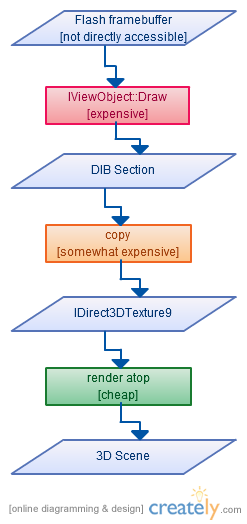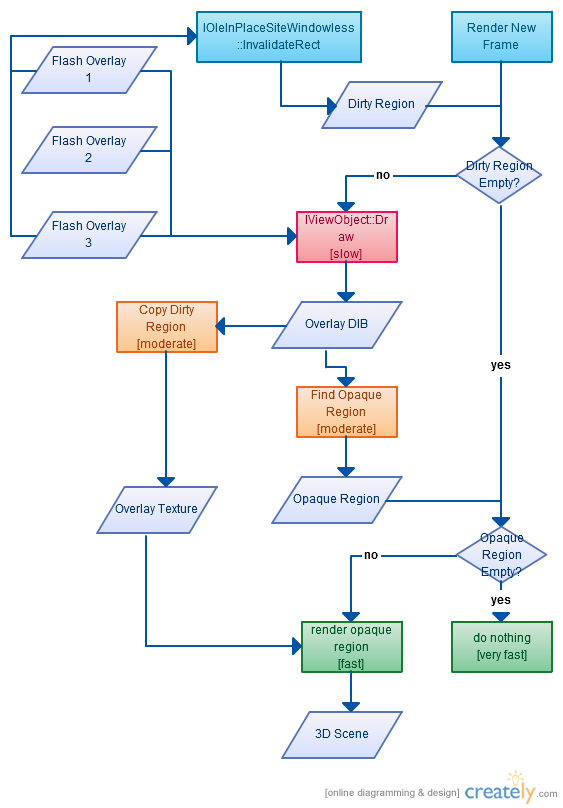By Chad Austin
Garbage Collection Doesn’t Mean You Can Ignore Memory Altogether…
Garbage collection removes a great deal of burden from programming. In fact, garbage collection is a critical language feature for all languages where abstractions such as functional closures or coroutines are common, as they frequently create reference cycles.
IMVU is a mix of C++ and Python. The C++ code generally consists of small, cohesive objects with a clear ownership chain. An Avatar SceneObject owns a ModelInstance which owns a set of Meshes which own Materials which own Textures and so on… Since there are no cycles in this object graph, reference-counting with shared_ptr suffices.
The Python code, however, is full of messy object cycles. An asynchronous operation may hold a reference to a Room, while the Room may be holding a reference to the asynchronous operation. Often two related objects will be listening for events from the other. While Python’s garbage collector will happily take care of cycles, it’s still possible to leak objects.
Imagine these scenarios:
- a leaked or living C++ object has a strong reference to a Python object.
- a global cache has a reference to an instance’s bound method, which implicitly contains a reference to the instance.
- two objects with __del__ methods participate in a cycle with each other, and Python refuses to decide which should destruct first
To detect these types of memory leaks, we use a LifeTimeMonitor utility:
a = SomeObject() lm = LifeTimeMonitor(a) del a lm.assertDead() # succeeds b = SomeObject() lm = LifeTimeMonitor(b) lm.assertDead() # raises ObjectNotDead
We use LifeTimeMonitor’s assertDead facility at key events, such as when a user closes a dialog box or 3D window. Take 3D windows as an example. Since they’re the root of an entire object subgraph, we would hate to inadvertently leak them. LifeTimeMonitor’s assertDead prevents us from introducing an object leak.
It’s good to know that an object leaked, but how can you determine why it can’t be collected?
Python’s Garbage Collection Algorithm
Let’s go over the basics of automatic garbage collection. In a garbage-collected system there are objects and objects can reference each other. Some objects are roots; that is, if an object is referenced by a root, it cannot be collected. Example roots are the stacks of live threads and the global module list. The graph formed by objects and their references is the object graph.
In SpiderMonkey, Mozilla’s JavaScript engine, the root set is explicitly-managed. SpiderMonkey’s GC traverses the object graph from the root set. If the GC does not reach an object, that object is destroyed. If C code creates a root object but fails to add it to the root set, it risks the GC deallocating the object while it’s still in use.
In Python however, the root set is implicit. All Python objects are ref-counted, and any that can refer to other objects — and potentially participate in an object cycle — are added to a global list upon construction. Each GC-tracked object can be queried for its referents. Python’s root set is implicit because anyone can create a root simply by incrementing an object’s refcount.
Since Python’s root set is implicit, its garbage collection algorithm differs slightly from SpiderMonkey’s. Python begins by setting GCRefs(o) to CurrentRefCount(o) for each GC-tracked PyObject o. Then it traverses all referents r of all GC-tracked PyObjects and subtracts 1 from GCRefs(r). Then, if GCRefs(o) is nonzero, o is an unknown reference, and thus a root. Python traverses the now-known root set and increments GCRefs(o) for any traversed objects. If any object o remains where GCRefs(o) == 0, that object is unreachable and thus collectible.
Finding a Path From the Nearest Root to the Leaked Object
Now that we know how Python’s garbage collector works, we can ask it for its set of roots by calculating GCRefs(o) for all objects o in gc.get_objects(). Then we perform a breadth-first-search from the root set to the leaked object. If the root set directly or indirectly refers to the leaked object, we return the path our search took.
Sounds simple, but there’s a catch! Imagine that the search function has signature:
PyObject* findPathToNearestRoot(PyObject* leakedObject);
leakedObject is a reference (incremented within Python’s function-call machinery itself) to the leaked object, making leakedObject a root!
To work around this, change findPathToNearestRoot so it accepts a singleton list containing a reference to the leaked object. findPathToNearestRoot can borrow that reference and clear the list, ensuring that leakedObject has no untracked references.
findPathToNearestRoot will find paths to expected Python roots like thread entry points and module objects. But, since it directly mirrors the behavior of Python’s GC, it will also find paths to leaked C references! Obviously, it can’t directly point you to the C code that leaked the reference, but the reference path should be enough of a clue to figure it out.
The Code
template<typename ArgType>
void traverse(PyObject* o, int (*visit)(PyObject* visitee, ArgType* arg), ArgType* arg) {
if (Py_TYPE(o)->tp_traverse) {
Py_TYPE(o)->tp_traverse(o, (visitproc)visit, arg);
}
}
typedef std::map<PyObject*, int> GCRefs;
static int subtractKnownReferences(PyObject* visitee, GCRefs* gcrefs) {
if (gcrefs->count(visitee)) {
Assert(PyObject_IS_GC(visitee));
--(*gcrefs)[visitee];
}
return 0;
}
typedef int Backlink; // -1 = none
typedef std::vector< std::pair<Backlink, PyObject*> > ReferenceList;
struct Referents {
std::set<PyObject*>& seen;
Backlink backlink;
ReferenceList& referenceList;
};
static int addReferents(PyObject* visitee, Referents* referents) {
if (!referents->seen.count(visitee) && PyObject_IS_GC(visitee)) {
referents->referenceList.push_back(std::make_pair(referents->backlink, visitee));
}
return 0;
}
static Backlink findNextLevel(
std::vector<PyObject*>& chain,
const ReferenceList& roots,
PyObject* goal,
std::set<PyObject*>& seen
) {
if (roots.empty()) {
return -1;
}
for (size_t i = 0; i < roots.size(); ++i) {
if (roots[i].first != -1) {
if (goal == roots[i].second) {
chain.push_back(goal);
return roots[i].first;
}
seen.insert(roots[i].second);
}
}
ReferenceList nextLevel;
for (size_t i = 0; i < roots.size(); ++i) {
Referents referents = {seen, i, nextLevel};
traverse(roots[i].second, &addReferents, &referents);
}
Backlink backlink = findNextLevel(chain, nextLevel, goal, seen);
if (backlink == -1) {
return -1;
}
chain.push_back(roots[backlink].second);
return roots[backlink].first;
}
static std::vector<PyObject*> findReferenceChain(
const std::vector<PyObject*>& roots,
PyObject* goal
) {
std::set<PyObject*> seen;
ReferenceList unknownReferrer;
for (size_t i = 0; i < roots.size(); ++i) {
unknownReferrer.push_back(std::make_pair<Backlink>(-1, roots[i]));
}
std::vector<PyObject*> rv;
// going to return -1 no matter what: no backlink from roots
findNextLevel(rv, unknownReferrer, goal, seen);
return rv;
}
static object findPathToNearestRoot(const object& o) {
if (!PyList_Check(o.ptr()) || PyList_GET_SIZE(o.ptr()) != 1) {
PyErr_SetString(PyExc_TypeError, "findNearestRoot must take a list of length 1");
throw_error_already_set();
}
// target = o.pop()
object target(handle<>(borrowed(PyList_GET_ITEM(o.ptr(), 0))));
if (-1 == PyList_SetSlice(o.ptr(), 0, 1, 0)) {
throw_error_already_set();
}
object gc_module(handle<>(PyImport_ImportModule("gc")));
object tracked_objects_list = gc_module.attr("get_objects")();
// allocating the returned list may have run a GC, but tracked_objects won't be in the list
std::vector<PyObject*> tracked_objects(len(tracked_objects_list));
for (size_t i = 0; i < tracked_objects.size(); ++i) {
object to = tracked_objects_list[i];
tracked_objects[i] = to.ptr();
}
tracked_objects_list = object();
GCRefs gcrefs;
// TODO: store allocation/gc count per generation
for (size_t i = 0; i < tracked_objects.size(); ++i) {
gcrefs[tracked_objects[i]] = tracked_objects[i]->ob_refcnt;
}
for (size_t i = 0; i < tracked_objects.size(); ++i) {
traverse(tracked_objects[i], subtractKnownReferences, &gcrefs);
}
// BFS time
std::vector<PyObject*> roots;
for (GCRefs::const_iterator i = gcrefs.begin(); i != gcrefs.end(); ++i) {
if (i->second && i->first != target.ptr()) { // Don't count the target as a root.
roots.push_back(i->first);
}
}
std::vector<PyObject*> chain = findReferenceChain(roots, target.ptr());
// TODO: assert that allocation/gc count per generation didn't change
list rv;
for (size_t i = 0; i < chain.size(); ++i) {
rv.append(object(handle<>(borrowed(chain[i]))));
}
return rv;
}



